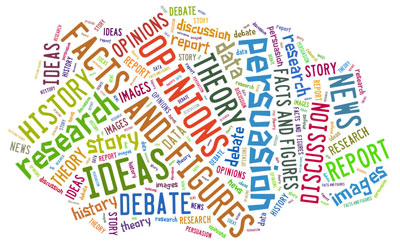1 Your information landscape
You may not have thought of yourself as having an ‘information landscape’. The term is used to refer to the range of information used in everyday life, at work and for study. Everyone is different and therefore information landscapes vary. It is likely that your information landscape will reflect your interests and relate to different parts of your life.
Not every source in your information landscape will be online. For instance, at work your colleagues are likely to be an important source of information. There will be shared understandings about what information means and how it is used in particular workplace settings, for example, healthcare or law. You’ll think about your information landscape as a whole before considering in more detail your online information landscape. This will help you to set the context for your digital life.
The image below includes words describing different categories of information.
This next activity helps you to think about your information landscape, both digital and real-life, and relate the categories of information to different parts of your life.
Activity 1 Getting orientated
Below are four different areas of life, each of which might form part of your information landscape. For each heading, some categories of information are suggested. The list is not exhaustive.
As you read about the categories of information listed under each heading, note down which ones you use. Are there others, not listed, that you would add? Make a note of these.
Select ‘Reveal feedback’ when you are ready.
You
- Ideas and opinions: your own and those of your family and friends.
- Research: you have done yourself (for example, on the internet).
- Experience: your own, and your family and friends.
Your local community
- News: local newspapers, local television, radio.
- Ideas and opinions: local media and community groups.
- Research: public library (physical or online resources).
- Facts and figures: local library or council, local club meetings and community groups.
- Historical information: archives of local organisations or the local press.
- Experience: local support groups.
Your workplace, college or university
- News: noticeboards, meetings, emails, social media, colleagues, meeting minutes, company intranet.
- Ideas and opinions: colleagues and discussion groups.
- Research: journal articles held in the library, project reports, product test logs.
- Facts and figures: from the information department, or any information systems you have access to, project specifications, orders, contract orders, technical data sheets, product manuals.
- Historical information: notes, records and archives.
- Experience: refer to colleagues, clients and customers, tutors, teachers, and fellow students.
Your world view
- News: the media (newspapers, TV, radio) or the specialist press, social media.
- Ideas and opinions: broadcast media, conferences, information from experts and relevant organisations, social media.
- Research results: national libraries, specialist organisations, relevant journals.
- Facts and figures: national libraries, government statistical services.
- Historical information: records offices and national libraries.
- Experience: national support groups, specialist charities.
Feedback
In practice, most of these information sources exist in digital form. National and international news is generally digital these days and breaking news is often shared on social media such as Twitter or Facebook before it reaches broadcast media.
To use some information sources effectively, especially in more local contexts, a two-way conversation is needed. For example, in the workplace, when asking a work colleague about their experience of a particular job area or issue, you will probably want to clarify and ask further questions depending on the response. This might be by email or in person. Without this clarification, misunderstandings can occur. Information and communication go hand in hand, there is dialogue involved and shared understandings evolve over time.
Information landscapes are therefore not fixed. They change as your circumstances change, as you move into new areas of life and as you engage with new communities. There may be overlap between different parts of your information landscape. In the next activity, you will think about your information landscape and how it has changed.

